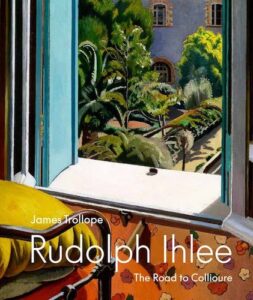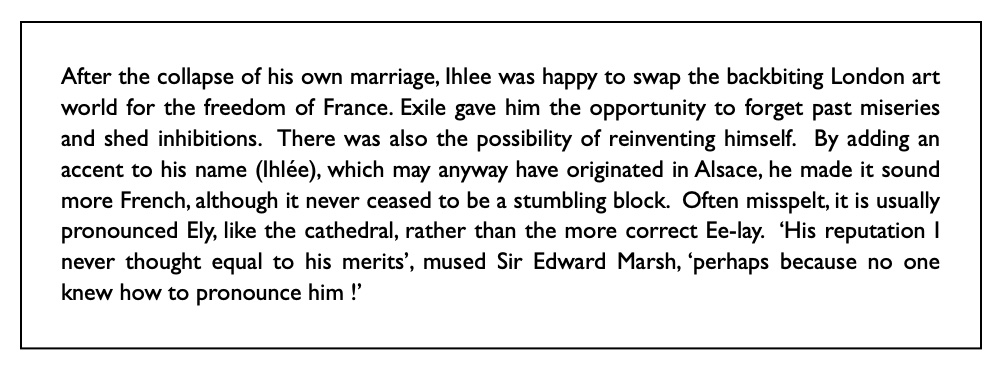
The book arrived promptly. It contained many beautiful examples of Rudolph Ihlee’s work, sumptuous landscapes from his time in the Pyrénèes-Orientales. And helpfully it provided some detail about his origins, and his early days.
Rudolph’s family had moved from Germany in the 1860’s. He was born in Wimbledon in January 1883, being the eighth of nine children. Rudolph’s father Heinrich built a business creating woollen clothing, based on the theories of a german botanist. The company was originally called Dr Jaeger’s Sanitary Woollen System Co. Ltd, but soon grew into the world famous Jaeger brand. The business provided an income stream for the family, which was invaluable when Henry died in 1891, and his wife moved back to Germany with most of her children. Rudolph stayed behind, along with his elder brother Frederick and his sister Gertrude.
Frederick became a surrogate parent and mentor to Rudolph. His background and aptitude for engineering had taken him to a position of management in an engineering firm which had relocated from London to Peterborough. Frederick wanted Rudolph to follow him in this career, and paid for him to enroll in an engineering apprenticeship. Rudolph became a qualified and skilled draughtsman, but had also become a serious painter, and eventually took himself off to the Slade School of Art in London. He quickly showed his talent, particularly for drawing, and won prizes in his first year. As his reputation grew, so did his circle of friends, and he began taking painting trips to Brittany with a close friend called Edgar Hereford.
Hereford was the son of a naval captain and was a dwarf, and somewhat of an outsider at the Slade. But their friendship grew, and in 1918, Edgar was there for support when Rudolph’s marriage broke down. In 1913, Rudolph had quietly married Sophia Roith, a refugee from the Belarus region of Russia, and set up home in Kensington. But when war broke out in 1914, his brother Frederick called him for help. Anti-German sentiment in Peterborough was assuaged when Frederick renamed his company from the germanic-sounding Werner, Pfleiderer & Perkins to Perkins Engineering Ltd (later to become Baker Perkins), and turned over all production to the war effort. At his brother’s behest, Rudolph relocated to Peterborough to work as a draughtsman in the factory (producing some very fine line drawings of munitions being assembled), while Sophia stayed in London and begin an affair with a naval lieutenant called Algernon William Farnsworth Smith. In the divorce proceedings in 1918, it became clear that the adulterous couple had fled to Paris and set up home.
After the war, single again, and needing to pick up his artistic career, Rudolph moved into Edgar Hereford’s house in Drayton Gardens. By 1921 he had reestablished his reputation in the London art scene, but with less financial success. In addition, his decree absolute had come through, and sadly Edgar Hereford had by now lost both his parents. So with no family ties, the friends set off on the foreign adventure which was to shape their lives.
After a brief stay in Algiers, Ihlee and Hereford relocated to a town called Collioure in the Pyrénèes-Orientales region of France, and painted many pictures of the sun-bleached, rocky landscape and stone buildings. They returned back to England as WWII began, both bringing wives, and settled into quiet lives near each other in East Anglia. Hereford died in 1953 in Swinstead, near Grantham, while Rudolph Ihlee passed away in 1968 in his home in West Deeping.
The biographical details of Rudolph’s life, as laid out in James’ marvelous book, did not provide any definitive lineage to the family folklore I was invested in. But there were several areas where the biographical facts could provide plausible answers to some of the mysteries.
I had always wondered how my grandmother Rose had, as a young girl, gone from a lowly farming family in the Fens to working in a large house in Kensington. Now I knew that not only had Frederick moved his company from London to Peterborough in 1904, but that Rudolph had also lived in digs in Peterborough during the war. It’s not hard to imagine that contact might have been made between the families, or even the parties themselves. The opportunity for a big adventure in London would be very attractive to a country girl.
Edgar Hereford was a dwarf – might he have been the ‘little man’ who turned up in Whittlesey to try and take the baby to London ?
My Dad’s family had been given everyday names – his aunts were called Hilda, Elsie and Hettie, he had uncles called Leonard and Ernest. My dad was christened Algernon Frederick – names that would have been jarringly conspicuous in a farming family, but could have been taken from the Rudolph Ihlee’s faithful brother, and the man who stole his wife ?
Most intriguingly, James Trollope provides a paragraph about the pronunciation of Rudolph’s family name;

All through my research, in my head I had been pronouncing the name as Eye-lee. When my Mum told me that the gentleman’s name was ‘Sir Algernon Ely or something like that’, then perhaps she was closer than we thought…

Leave a Reply